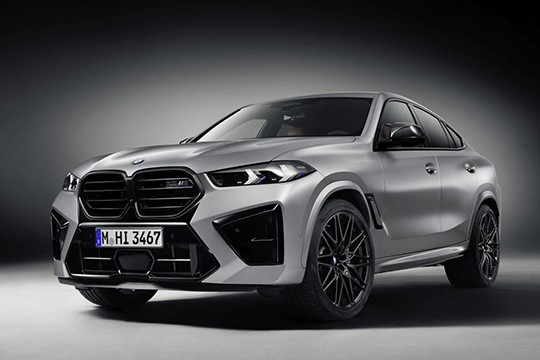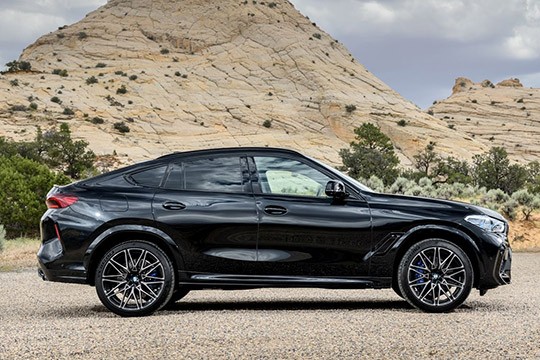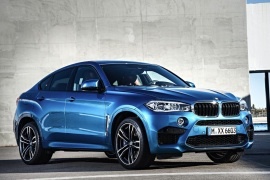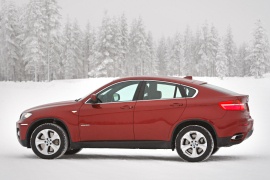BMW X6 M Models/Series Timeline, Specifications & Photos
First production year: 2009
Engines: Mild hybrid, Gasoline
Body style: SUV (Sports Utility Vehicle)
BMW refreshed the X6 lineup at the beginning of 2023, and along with the rest of the range, the M Competition version received a well-deserved update.
The world of performance SUVs was no longer a territory where just one or two brands dominated the market. Apart from Porsche's Cayenne and its sibling Lamborghini Urus, Aston Martin, Mercedes-Benz, BMW, and Cadillac joined the bandwagon. We didn't mention Ferrari since the Italian brand didn't say that the Purosangue was an SUV (although it was). So, in this small circle of powerful vehicles, the white-and-blue badged automaker from Munchen had to stay ahead of the game to attract more customers.
BMW celebrated 50 years of its performance division M in 2022, and at the beginning of the following year, it introduced a facelift for the entire X6 range. And that meant some changes for the M Competition version as well. The car's exterior got new, slimmer headlights and a redesigned, broader grille that was flanked by wider air intakes to cool the brakes. In addition, the lower bumper sported a second grill with an integrated radar for adaptive cruise control, automatic braking, and other safety systems.
Inside, customers were greeted by high-bolstered sports seats and a curved display on top of the dashboard. Fronting the driver was the instrument panel, while atop the center stack was the iDrive 8 infotainment touchscreen.
But the most significant changes were made under the car's skin. While the ICE powerplant remained the same, the automaker added a 48V mild-hybrid system that helped the car get improved fuel efficiency. In addition, there was a new eight-speed automatic gearbox with revised gear ratios when compared to its predecessor.
BMW X6 M Competition Competition 4.4L V8 xDrive 48V MHEV AWD 8AT (625 HP)
With 600 hp under the hood, the X6 M tried to offer more performance for the SUV-lovers in a package that started the SUV-coupe trend.
When the first X6 came on the market in 2007, it received as much appreciation as hate from its fans. But BMW didn't care too much about that and pushed forward, and soon, the customers started to like it. By 2019, the X6 was already at its third generation, and its main competitors tried to catch it.
BMW offered a special exterior package for the X6 M. The front bumper sported a unique design with a wide center grille flanked by two side-scoops. In addition to these, another pair of slimmer air-intakes found their place on the lowest side of the apron. The laser light system was a standard feature for the X6 M and X6 M Competition Package. Worth mentioning that every aerodynamic detail of the car was functional, including the twin rear spoilers, mounted at the top side of the liftgate and on the lower flat panel, above the LED taillights. A set of four, round exhausts poked underneath the car.
Inside, the carmaker installed a leather-clad cabin. Its front bucket seats with high-bolstered areas and integrated headrest promised excellent side support during hard cornering. For the rear seats, BMW installed a bench for three. The dashboard featured slim vents on the center stack, under the wide, 12.3" infotainment display. For the 2019 model, the X6 M sported a 12.3" digital instrument panel.
Under the hood, BMW M installed an evolved 4.4-liter twin-turbo engine. Unlike its predecessor, which offered 575 hp, the 2019 model provided 600 hp for the regular M and 625 for the Competition Package version.
Despite being an unusual-looking crossover, the X6 M was a vehicle that felt at home on a winding road, on a race track, or in parking in front of a school.
When BMW introduced the first generation of the X6, it started the trend of the SUV-coupe. Even though many people complained about the vehicle's design, they all agreed that it was built excellently. Sure, there were some issues with the interior room and other bits and pieces. But none of them were targeted toward the car's driving dynamics. And then, when customers got used to the X6's performance, they got this: the M version.
While most of the car's body parts were the same as in the regular X6, there were a few things that were different. For instance, the front lower bumper featured a larger center grille flanked by two functional side scoops. Then, behind the front wheel arches were vents that extracted the air trapped in the wheel well. But the automaker didn't want to overdo things and didn't adorn the sloped-back tailgate with a roof spoiler. It placed a small lip lower, not to increase the downforce but to keep the wide taillights clean from dust and debris while driving at high speeds.
Inside, BMW prepared a cabin fit for up to five adults with front high-bolstered seats. In addition, the automaker offered a few trims and materials options. On the instrument cluster, the classic BMW four dials display was complemented by a small display for the onboard computer. The iDrive infotainment system was placed atop the center stack and controlled via a rotary knob and six buttons housed on the center stack. In the back, the sloped-back roofline affected the headroom for the rear-seated passengers.
But the magic happened under the car's skin. A 4.4-liter twin-turbocharged engine sent its twisting force via an eight-speed automatic transmission. The all-wheel drive system was standard.
What was it really? A hatchback? An SUV? A crossover? Well, all of them. A jacked-up hatchback with a very precise steering and ridiculous power.
Sure, everything sounds nice, but it had to come with some compromises: limited cargo space and seating for four.
Not a practical or versatile vehicle, but a great option for passionate drivers.
The X6M was developed by the BMW’s Motorsport division and featured a twin-turbocharged 4.4-liter V8 engine that cranked out no less than 555 hp, and that’s 5 hp more than the engine on the Caynne Turbo S.
Interesting for a crossover, the X6M drove like a sports sedan and was equipped with 20-inch alloys and a special-sport-tuned adaptive suspension.
The X6M offered seating for 4 and featured an ample list of standard features such as 20-inch alloys, a self-leveling electronically adjustable active suspension, front and rear parking sensors, xenon headlamps, headlight washers, a power liftgate, a panoramic sunroof, leather upholstery, dual-zone automatic climate control, ambient interior lighting, Bluetooth connectivity and a hard-drive-based navigation system with real-time traffic.
Optional features included soft-close automatic doors, ventilated seats, heat steering wheel, heated rear seats, a rearview camera, a head-up display, a 16-speaker premium sound system, keyless entry, a rear-seat entertainment system and towing preparation.
Only 4,8 seconds in the sprint to 100 km/h was impressive for a 2,500 kg vehicle.
Standard safety features included ABS, stability control, numerous airbags and whiplash-reducing front head restraints.



